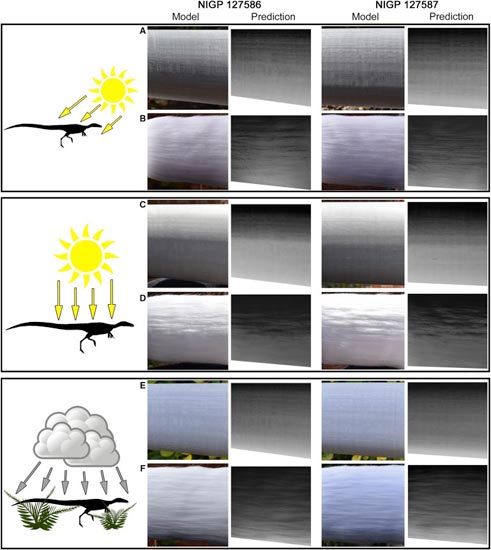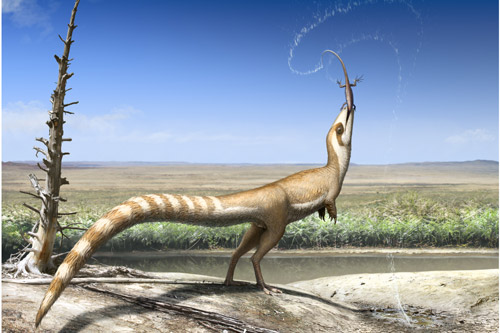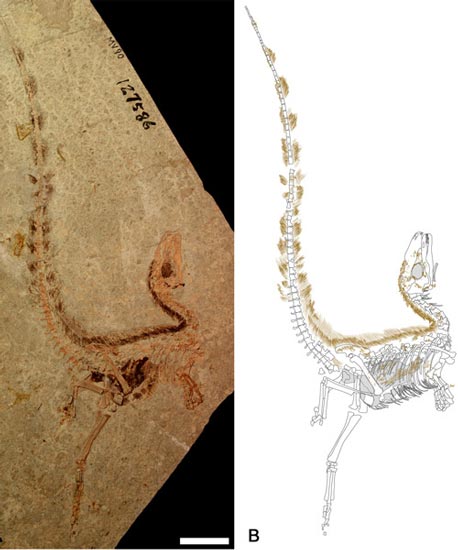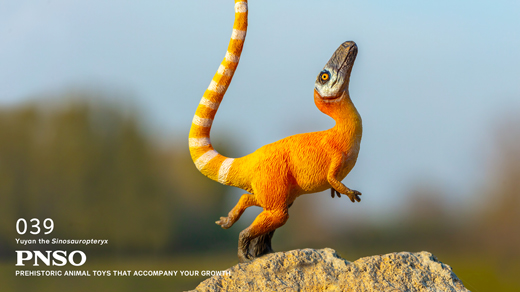Dinosaur Had Bandit Mask-like Stripe Across Its Eyes
Researchers from Bristol University have revealed how a small, feathered, compsognathid dinosaur used its colour patterning, including a bandit mask-like stripe across its eyes, to avoid being detected by its predators and prey. This research has also allowed the authors of the scientific paper, published this week in “Current Biology”, to infer the sort of habitat that this little dinosaur might have lived in.
Once thought of being part of the fauna of the forest, it seems that Sinosauropteryx (S. prima), might have favoured more open environments.
An Illustration of Sinosauropteryx (S. prima) Hunting in an Open Environment
Picture credit: Bob Nicholls
In the image created by Bob Nicholls (above), Sinosauropteryx is shown in an open habitat and it has just captured a lizard (Dalinghosaurus).
Multiple Types of Camouflage
Analysis of the preserved melanosomes enabled the team to reconstruct the likely colour patterning of this one-metre-long dinosaur. The scientists conclude that Sinosauropteryx had multiple types of camouflage which helped it keep hidden from its prey as well as assisting in the avoidance of detection by much larger theropods and other predators. The authors of the paper include corresponding author Jakob Vinther, Innes C. Cuthill, Fiann Smithwick from Bristol University as well as palaeoartist Bob Nicholls.
Fiann (School of Earth Sciences) stated:
“Far from all being the lumbering prehistoric grey beasts of past children’s books, at least some dinosaurs showed sophisticated colour patterns to hide from and confuse predators, just like today’s animals.”
Sinosauropteryx Fossil Specimen and Accompanying Line Drawing Showing Shading
Picture credit: Bristol University
He went onto add:
“Vision was likely very important in dinosaurs, just like today’s birds, and so it is not surprising that they evolved elaborate colour patterns.”
Mapping Melanosomes and Comparative Anatomy
The study involved plotting how the dark pigmented feathers were distributed across the dinosaur’s body and then this pattern was compared to the patterns seen in extant animals and from this the optimum habitat to best maximise the camouflage was inferred. Similar countershading patterns are found in many living animals and birds today. The “bandit mask”, the dark stripe around the eye, is found in badgers, raccoons, red pandas and in birds such as the shrike.
In animals such as raccoons and badgers, the “bandit mask” acts as a warning, it advertises the fact that these animals are aggressive with teeth and claws that could cause considerable damage if another animal attacked them. The research team discount this reason for Sinosauropteryx’s “Lone Ranger mask”, as an Everything Dinosaur team member calls it, Sinosauropteryx probably relied on its speed to avoid predation, it did not have very big teeth or strong claws required to back up such a visual statement. The more likely reason for the bandit mask might be that it helped reduce glare from light reflected on feathers around the eye, just like in some modern birds.
Many sports stars such as American footballers and cricketers apply black greasepaint underneath their eyes. It is believed to lessen the effect of the glare from direct sunlight or from stadium lights. It helps them to see better, the “bandit mask” of Sinosauropteryx may have helped it to see better in bright sunlight. This idea supports the view that Sinosauropteryx was a creature of open, brightly lit habitats.
An Illustration of Sinosauropteryx Sporting its “Bandit Mask”

Schematic illustration based on the distribution of pigmented plumage in two specimens highlighting the level of the countershading transition from a dark back to light underbelly, scale bar represents 10 cm.
Picture credit: Bristol University
Lead author, Dr Jakob Vinther, commented:
“Dinosaurs might be weird in our eyes, but their colour patterns very much resemble modern counterparts. They had excellent vision, were fierce predators and would have evolved camouflage patterns like we see in living mammals and birds.”
A Dark Back and Light Underside – Countershading in the Dinosauria
The small dinosaur also showed a ‘counter-shaded’ pattern with a dark back and light belly; a pattern used by many modern animals to make the body look flatter and less three-dimensional. This helps to prevent animals standing out from their background, making them harder to see, assisting in the avoidance of detection by would-be predators and potential prey.
Previous work on modern animals, carried out by one of the authors, Bristol’s Professor Innes Cuthill, has shown that the precise pattern of countershading relates to the specific environments in which animals live. Animals living in open habitats, such as grasslands and plains, often have a countershaded pattern that goes from dark to light sharply and high on the side of the body, while those living in more closed habitats, arboreal habitats like forests, usually show a more gradual change in the colouration from a dark back to a lighter underside.
This idea was applied to Sinosauropteryx, and allowed for the reconstruction of its habitat 130 million years ago. As part of the Jehol Biota, Sinosauropteryx was believed to have lived in a forested environment, but the countershading on Sinosauropteryx went from dark to light high on the body, suggesting that it would be more likely to live in open habitats with minimal vegetation.
Predicting the Countershading Pattern and Inferring the Habitat

3-D models of the abdomen countershading predicted following an assessment of pigmentation from two fossil specimens. (NIGP 127586 and NIGP 127587).
Picture credit: Bristol University
The Differing Pattern of Predicted Self-Shadowing in Sinosauropteryx
The picture above shows three-dimensional models of the abdomen of two fossil specimens of Sinosauropteryx involved in the study (NIGP 127586 and NIGP 127587). These fossils were imaged under different lighting conditions. “Model” represents the original photographs taken of the models to show how the self-shadows are cast across each, with and without synthetic fur added to mimic the impact of a coat of feathers. “Prediction” shows how a gradient of pigment dorsoventrally (from the back down the flank to the underbelly), would be expected to perfectly counterbalance the illumination gradient caused by self-shadowing.
(A and B) = direct sunlight at an altitude of around 30° on smooth and “feathered” models.
(C and D) = direct sunlight at an altitude of 90° on smooth and “feathered” models.
(E and F) = diffuse lighting under 100% cloud cover (which equates to a closed environment, such as a forest) on smooth and “feathered” models.
Studying Countershading
The ventral position and sharpness of the predicted countershading transition can be seen to be higher and sharper under overhead direct lighting, indicative of an open environment (C and D), whereas under diffuse lighting, representing a closed habitat, the transition is lower and more gradual (E and F).
In countershaded animals the top surface (back) is darker and the lower surface (underside) is lighter. This helps to even out the effect of shadowing caused by sunlight, so countershaded animals appear less three-dimensional, helping the animal to avoid detection by predators and to assist it in sneaking up on its prey. Crucially, lighting conditions vary depending on the environment.
Animals living in open areas with lots of light, such as grasslands, tend to have a sharp dark to light transition high up on the body, whereas in contrast, animals living in areas with less direct sunlight, such as wooded areas, tend to have more gradual transitions positioned lower down. This means that the research team could infer the likely habitat of Sinosauropteryx based on the pattern of its countershading.
Three-dimensional models of the dinosaur’s body were made in a bid to determine in which environment the countershading pattern seen on Sinosauropteryx would be most effective. The models were photographed in varying light conditions and the shadowing observed, the team then compared these results to the actual countershading pattern detected in the fossils. They determined that the countershading transition for Sinosauropteryx was abrupt and it occurred high up on the flank, the best position to minimise the effect of shadows cast by direct sunlight. It could therefore be inferred that Sinosauropteryx was best suited to an open environment.
A Model of Sinosauropteryx
The picture (above) shows a model of Sinosauropteryx in the PNSO model series.
To view this range: PNSO Age of Dinosaurs Models and Figures.
This study provides a new insight into the lives and behaviour of members of the Dinosauria helping to reconstruct the long-lost habitats in which they lived.
Co-author of the study, Professor Innes Cuthill, a behavioural ecologist commented:
“We’ve shown before that countershading can act as effective camouflage against living predators. It’s exciting that we can now use the colours of extinct animals to predict the sort of environment they lived in.”
Fiann Smithwick added:
“By reconstructing the colour of these long-extinct dinosaurs, we have gained a better understanding of not only how they behaved and possible predator-prey dynamics, but also the environments in which they lived. This highlights how palaeocolour reconstructions can tell us things not possible from looking at just the bones of these animals.”
Everything Dinosaur acknowledges the help of the University of Bristol in the compilation of this article.
Visit the Everything Dinosaur website: Everything Dinosaur.









Leave A Comment